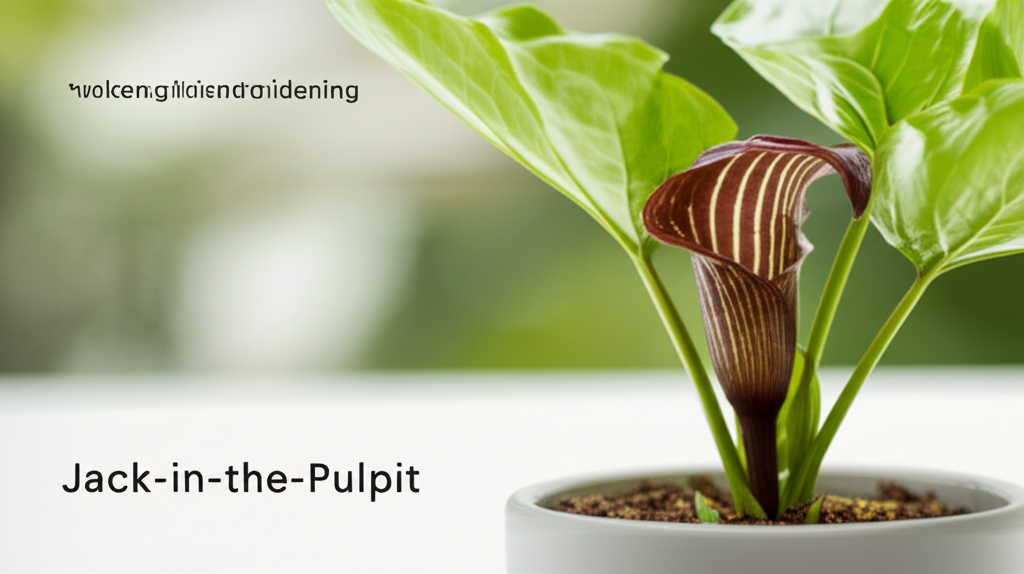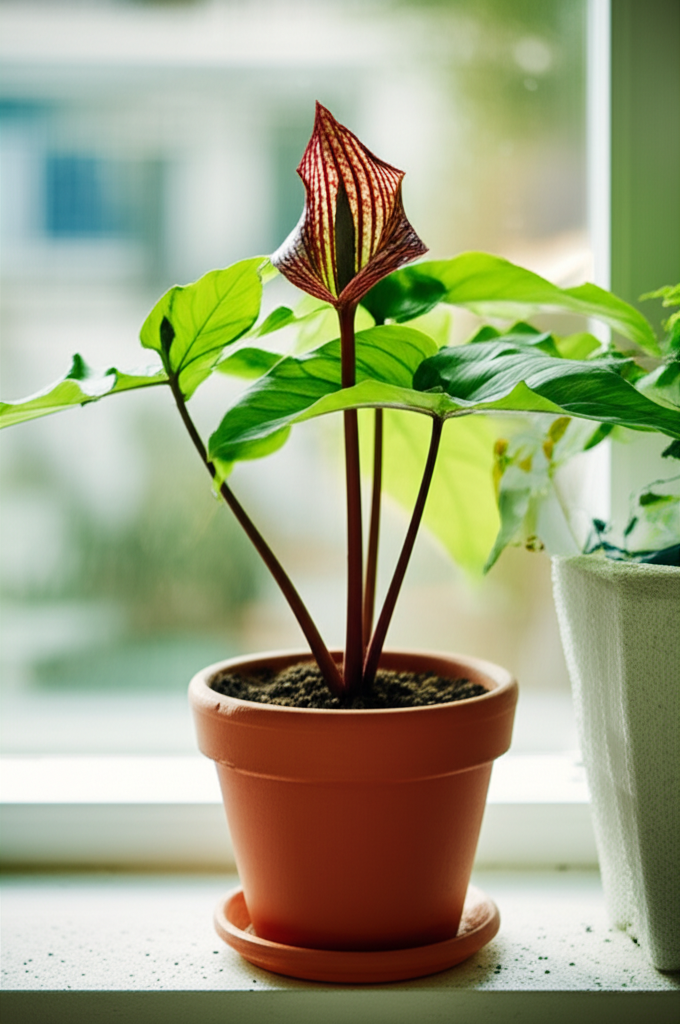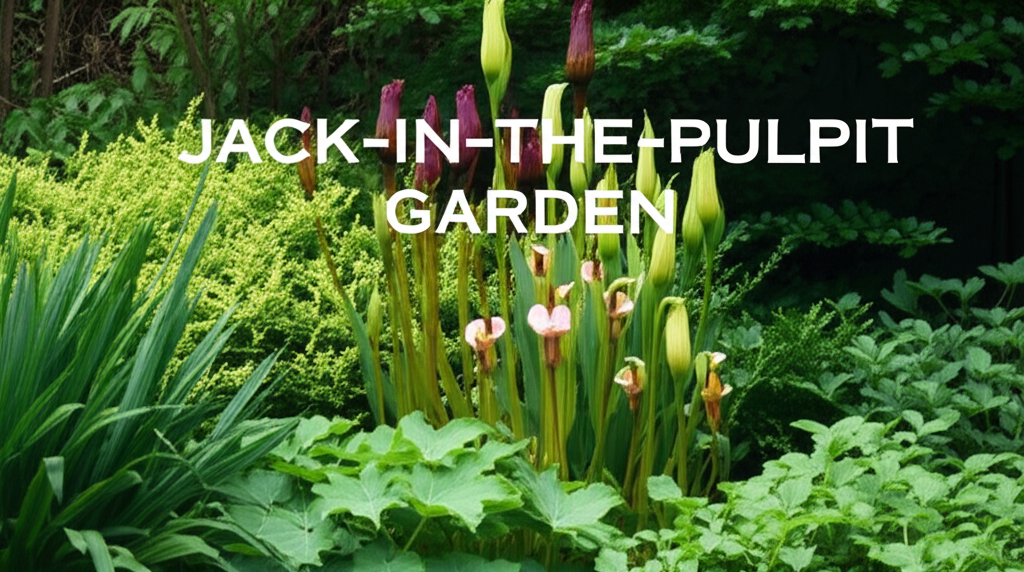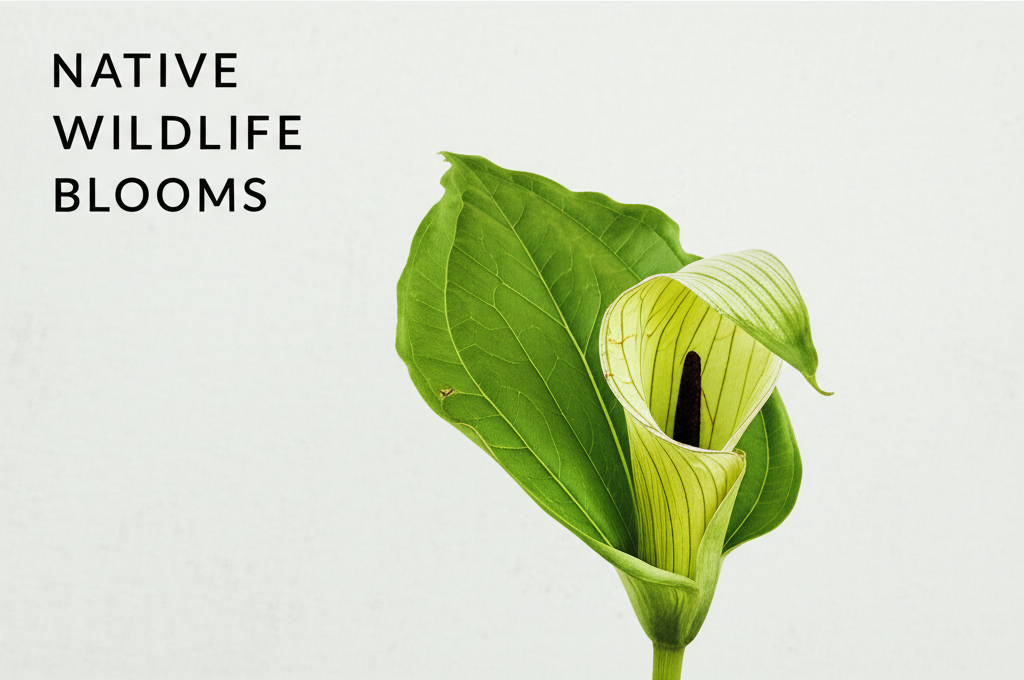Introduction to the Enigmatic Jack-in-the-Pulpit
For the aspiring container gardener seeking a plant that’s as fascinating as it is beautiful, look no further than the Jack-in-the-Pulpit (Arisaema triphyllum). This captivating woodland native, with its unique spathe and spadix structure resembling a preacher in his pulpit, offers a delightful challenge and reward for those new to growing plants in pots. While often found in the dappled shade of Eastern North American forests, its adaptable nature makes it a surprisingly suitable candidate for container cultivation, provided a few key conditions are met. This guide will equip beginner container gardeners with the knowledge and confidence to successfully cultivate this intriguing perennial.
Why Choose Jack-in-the-Pulpit for Your Container Garden?

The allure of the Jack-in-the-Pulpit extends beyond its striking appearance. As a beginner-friendly option, it offers several advantages:
- Unique Aesthetics: The distinctive “jack” (spathe) and “pulpit” (spadix) are unparalleled in the plant world, creating a natural conversation starter.
- Woodland Charm: It brings a touch of wild, native beauty to urban or suburban settings.
- Relatively Low Maintenance: Once established and provided with its preferred conditions, it requires minimal fuss.
- Fascinating Life Cycle: Observing its growth from tuber to flowering stalk, and eventually to bright red berries, is a rewarding experience.
- Adaptability to Containers: With the right soil and moisture, it thrives in pots, making it accessible to gardeners without traditional garden beds.
Understanding the Jack-in-the-Pulpit’s Needs
Before diving into the practicalities of container gardening, it’s crucial to understand the natural habitat and requirements of Arisaema triphyllum. This knowledge will inform every decision you make, from choosing a pot to selecting the right soil mix.
Light Requirements
In its natural environment, the Jack-in-the-Pulpit thrives in the dappled shade of deciduous forests. This translates to a preference for bright, indirect light when grown in containers.
- Ideal Location: East-facing balconies or patios are excellent as they receive gentle morning sun, followed by shade.
- Avoid Direct Sun: Intense afternoon sun, especially in warmer climates, can scorch the leaves and dry out the soil too quickly.
- Consider Shade: If your container location is consistently sunny, consider placing the pot beneath taller plants or using a shade cloth during the hottest parts of the day.
Soil and Drainage
This is perhaps the most critical aspect for successful container Jack-in-the-Pulpit cultivation. These plants are accustomed to moist, humus-rich, and slightly acidic woodland soils. Excellent drainage is paramount to prevent tuber rot.
- Essential Components: A good potting mix should be a blend of high-quality potting soil, compost or well-rotted leaf mold, and perlite or coarse sand for drainage.
- Acidic Preference: Aim for a slightly acidic pH (around 5.5-6.5). If your potting mix is neutral, you can amend it with a small amount of peat moss or coco coir.
- Drainage is Key: Ensure your chosen container has ample drainage holes. Adding a layer of gravel or broken pottery shards at the bottom of the pot is a common practice, though modern horticultural advice suggests this may not be as effective as ensuring the potting mix itself is free-draining.
Watering Needs
Jack-in-the-Pulpit prefers consistently moist soil, mimicking the damp forest floor. However, this does not mean waterlogged.
- Check Soil Moisture: Water thoroughly when the top inch of soil feels dry to the touch.
- Consistency is Crucial: Avoid letting the soil dry out completely, especially during the active growing season.
- Reduce Watering in Dormancy: As the plant dies back in late summer or fall, reduce watering significantly.
- Water Quality: If possible, use rainwater or filtered water, as some plants can be sensitive to chlorine and minerals found in tap water.
Temperature and Humidity
Native to temperate regions, Jack-in-the-Pulpit enjoys moderate temperatures and appreciates a bit of humidity.
- Growing Season: They prefer temperatures between 60-75°F (15-24°C) during their active growth period.
- Winter Dormancy: They require a cool to cold winter dormancy period, typically between 35-50°F (2-10°C).
- Humidity: While they appreciate humidity, they are generally tolerant of average household humidity levels. Grouping plants or placing the pot on a pebble tray filled with water can increase local humidity if needed.
Key Facts and Comparison for Container Jack-in-the-Pulpit
To better understand what to expect and how to manage your container-grown Jack-in-the-Pulpit, let’s compare it to more common container plants.
| Feature | Jack-in-the-Pulpit (Arisaema triphyllum) | Petunias (Petunia spp.) | Hostas (Hosta spp.) |
|---|---|---|---|
| Light Preference | Dappled Shade/Bright Indirect Light | Full Sun to Partial Shade | Partial Shade to Full Shade |
| Soil Requirement | Moist, Humus-Rich, Well-Draining, Slightly Acidic | Well-Draining, Moderately Fertile | Well-Draining, Humus-Rich |
| Watering | Consistently Moist, Avoid Waterlogging | Regular, Allow to Dry Slightly Between Waterings | Consistent Moisture, Tolerant of Drier Spells |
| Bloom Time | Spring (May-June) | Late Spring to Fall | Summer (though grown primarily for foliage) |
| Dormancy | Yes (Dies back in late summer/fall) | Typically Annual (in cooler climates) or Perennial (in warmer climates with protection) | Yes (Foliage dies back in fall) |
| Toxicity | Contains Calcium Oxalate Crystals (mildly toxic if ingested) | Generally Non-Toxic | Generally Non-Toxic |
Getting Started: Planting Your Jack-in-the-Pulpit in a Container
The process of planting your Jack-in-the-Pulpit tuber is straightforward, but attention to detail ensures a strong start.
Choosing the Right Container
The container you select will significantly impact the health and growth of your plant.
- Size Matters: Opt for a pot at least 8-10 inches in diameter and depth. A larger pot provides more space for root development and helps retain moisture.
- Material: Terracotta pots offer excellent breathability and drainage, but they can dry out quickly. Plastic or glazed ceramic pots retain moisture better but require careful monitoring to prevent waterlogging.
- Drainage Holes: As mentioned, this is non-negotiable. Ensure your pot has multiple drainage holes at the bottom.
Preparing the Potting Mix
A well-prepared soil blend is the foundation for success.
- Base: Start with a high-quality, peat-free potting mix.
- Amendments: Incorporate 20-30% compost or well-rotted leaf mold for nutrients and improved soil structure.
- Drainage Enhancer: Add 10-15% perlite, coarse horticultural sand, or small bark chips to ensure excellent drainage.
- Mixing: Thoroughly mix all components together until uniform.
Planting the Tuber
Jack-in-the-Pulpit tubers are typically planted in the fall, but can also be planted in early spring as soon as the soil can be worked.
- Depth: Plant the tuber about 3-4 inches deep, with the pointed or budded end facing upwards.
- Orientation: If you can discern a direction, plant with the growing point (often a slight indentation or a cluster of small buds) facing up. If unsure, plant horizontally or at a slight angle.
- Spacing: If planting multiple tubers in a larger pot, space them at least 6 inches apart to allow for growth.
- Watering In: Water thoroughly after planting to settle the soil around the tuber.
Ongoing Care and Maintenance
Once planted, providing consistent care will encourage healthy growth and the eventual emergence of its iconic flower.
Watering Schedule
Maintain consistent moisture in the soil, especially during the spring and early summer when the plant is actively growing.
- Spring/Summer: Water when the top inch of soil is dry. You may need to water every few days, depending on temperature and humidity.
- Fall: As the foliage begins to yellow and die back, gradually reduce watering.
- Winter: During dormancy, keep the soil barely moist, only watering if it feels completely dry.
Fertilizing
Jack-in-the-Pulpit is not a heavy feeder. Over-fertilizing can be detrimental.
- Spring Application: A light feeding with a balanced, slow-release organic fertilizer or a top dressing of compost in early spring, as new growth appears, is usually sufficient.
- Avoid Overdoing It: Too much nitrogen can lead to lush foliage at the expense of flowering or can make the plant more susceptible to rot.
Pest and Disease Management
Jack-in-the-Pulpit is generally resistant to pests and diseases, but some common issues can arise, especially in container settings.
- Root Rot: This is the most common problem, caused by overwatering and poor drainage. Ensure the soil stays moist but not waterlogged.
- Slugs and Snails: These can sometimes nibble on the emerging shoots and leaves. Hand-picking them in the early morning or evening or using organic slug bait can help.
- Aphids: Occasionally, aphids may appear on new growth. A strong spray of water or insecticidal soap can manage infestations.
Repotting
Jack-in-the-Pulpit does not need frequent repotting. They prefer to be slightly root-bound.
- Frequency: Repot every 2-3 years, or when the tuber fills the current pot.
- Timing: The best time to repot is during its dormant period, either in late fall after the foliage has died back or in early spring before new growth emerges.
- Process: Carefully remove the plant from its pot, gently loosen any circling roots, and repot into a slightly larger container with fresh potting mix.
The Life Cycle of Jack-in-the-Pulpit and Seasonal Care
Understanding the seasonal changes of your Jack-in-the-Pulpit will help you provide the appropriate care throughout the year.
Spring Emergence
As temperatures warm and soil moisture increases, you’ll see the unique hooded spathe and spadix emerge from the soil. This is the plant’s flowering stage.
- First Year: It’s common for young tubers to produce only leaves in their first year.
- Flowering: The characteristic flower appears on mature plants, usually in May or June.
- Leaf Formation: Three leaflets typically form on a single stalk.
Summer Growth and Seed Formation
After flowering, the plant continues to produce foliage. In late summer, if pollination has occurred, you might see bright red berries developing on the spadix.
- Pollination: Jack-in-the-Pulpit can be pollinated by flies and other small insects attracted to its unusual structure.
- Foliage Decline: As days shorten and temperatures cool, the foliage will begin to yellow and eventually die back.
Fall Dormancy
The plant enters dormancy as the leaves wither and disappear. This period is essential for its survival and next year’s growth.
- Leaf Drop: Allow the foliage to die back naturally; do not cut it off prematurely as it still provides nutrients to the tuber.
- Watering: Reduce watering significantly during this phase.
Winter Rest
The tuber rests underground (or in its pot). It needs protection from extreme cold if grown in a region with harsh winters.
- Protection: In very cold climates, consider moving the pot to an unheated garage, shed, or insulating it with burlap or mulch to protect the tuber from freezing solid.
- Moisture: Keep the soil slightly moist but not wet.
Troubleshooting Common Issues
Even beginner gardeners may encounter minor problems. Here’s how to address them:
Yellowing Leaves
- Early Season: If the leaves yellow before or shortly after flowering, it might indicate insufficient water or nutrients.
- Late Season: Yellowing in late summer is natural as the plant prepares for dormancy.
- Overwatering: Yellowing leaves that feel mushy can be a sign of root rot due to excessive moisture.
Lack of Flowers
- Young Plants: The most common reason for no flowers is that the tuber is too young. It typically takes 2-3 years for a tuber to mature enough to flower.
- Insufficient Light: While they prefer shade, too much deep shade can prevent flowering.
- Poor Nutrition: An unbalanced diet or lack of nutrients can also impact blooming.
Fungus Gnats
These tiny flies are attracted to consistently moist soil.
- Control: Allow the top inch of soil to dry out between waterings. Yellow sticky traps can also help catch adult gnats.
Pros and Cons of Container Gardening Jack-in-the-Pulpit
Every gardening endeavor has its advantages and disadvantages. Here’s a look at growing Jack-in-the-Pulpit in containers:
| Pros | Cons |
|---|---|
| Accessibility: Allows cultivation in areas without garden beds or with poor soil. | Watering Demands: Containers dry out faster than in-ground plantings, requiring more frequent monitoring. |
| Control: Easier to provide ideal soil and drainage conditions. | Temperature Fluctuations: Potting mix can heat up or cool down more rapidly than garden soil, potentially stressing the plant. | Limited Space: Growth and tuber development may be more restricted compared to in-ground planting. |
| Visual Interest: Can be strategically placed on patios or decks for maximum viewing pleasure. | Winter Protection: May require more effort to protect tubers from harsh winter conditions in colder climates. |
Conclusion: A Rewarding Journey
Cultivating Jack-in-the-Pulpit in containers offers a unique and accessible way for beginner gardeners to connect with a truly remarkable native plant. By understanding its specific needs for light, soil, and moisture, and by providing consistent, albeit minimal, care, you can enjoy the unfolding mystery of this fascinating perennial right at your doorstep. The patience required for its unique life cycle and the satisfaction of witnessing its iconic bloom make the Jack-in-the-Pulpit an excellent and rewarding choice for the adventurous beginner container gardener. Embrace the challenge, nurture this woodland wonder, and prepare to be captivated by its enigmatic charm.


